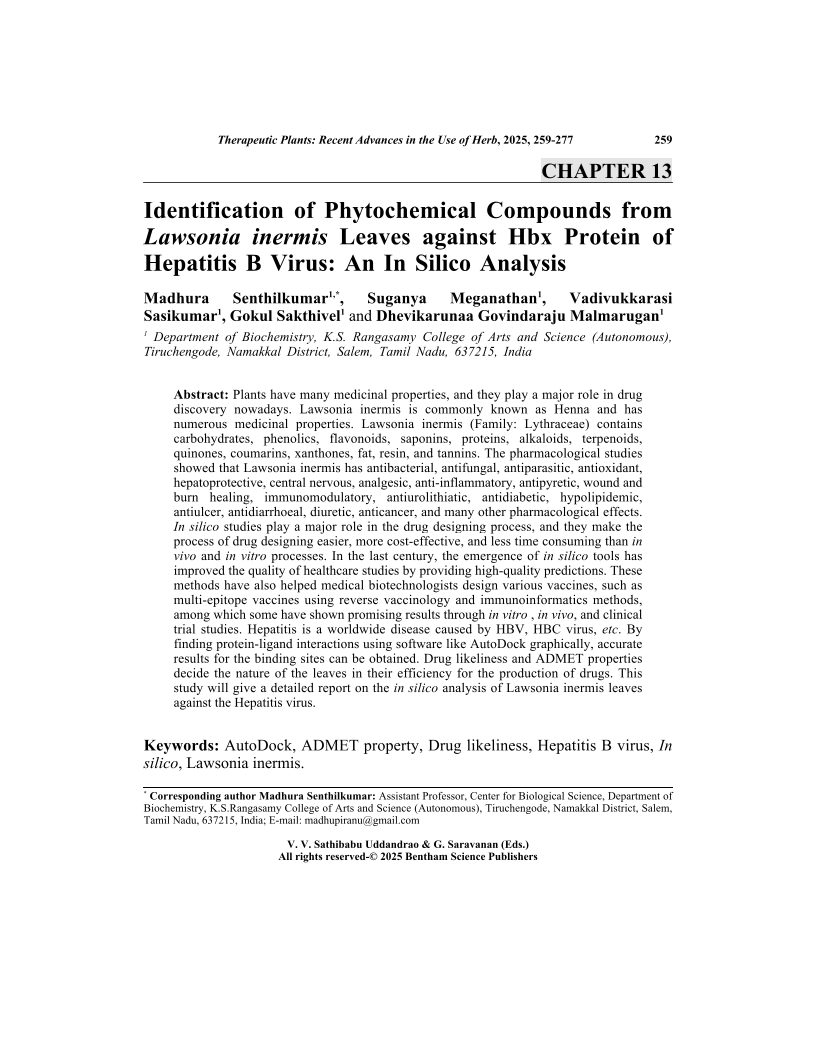Identification of Phytochemical Compounds from Lawsonia inermis Leaves against Hbx Protein of Hepatitis B Virus: An In Silico Analysis

- Authors: Madhura Senthilkumar1, Suganya Meganathan2, Vadivukkarasi Sasikumar3, Gokul Sakthivel4, Dhevikarunaa Govindaraju Malmarugan5
-
View Affiliations Hide Affiliations1 Department of Biochemistry, K.S. Rangasamy College of Arts and Science (Autonomous), Tiruchengode, Namakkal District, Salem, Tamil Nadu, 637215, India 2 Department of Biochemistry, K.S. Rangasamy College of Arts and Science (Autonomous), Tiruchengode, Namakkal District, Salem, Tamil Nadu, 637215, India 3 Department of Biochemistry, K.S. Rangasamy College of Arts and Science (Autonomous), Tiruchengode, Namakkal District, Salem, Tamil Nadu, 637215, India 4 Department of Biochemistry, K.S. Rangasamy College of Arts and Science (Autonomous), Tiruchengode, Namakkal District, Salem, Tamil Nadu, 637215, India 5 Department of Biochemistry, K.S. Rangasamy College of Arts and Science (Autonomous), Tiruchengode, Namakkal District, Salem, Tamil Nadu, 637215, India
- Source: Therapeutic Plants: Recent Advances in the Use of Herbs as Alternative Medications , pp 259-277
- Publication Date: May 2025
- Language: English
Identification of Phytochemical Compounds from Lawsonia inermis Leaves against Hbx Protein of Hepatitis B Virus: An In Silico Analysis, Page 1 of 1
< Previous page | Next page > /docserver/preview/fulltext/9789815322910/chapter-13-1.gif
Plants have many medicinal properties, and they play a major role in drug discovery nowadays. Lawsonia inermis is commonly known as Henna and has numerous medicinal properties. Lawsonia inermis (Family: Lythraceae) contains carbohydrates, phenolics, flavonoids, saponins, proteins, alkaloids, terpenoids, quinones, coumarins, xanthones, fat, resin, and tannins. The pharmacological studies showed that Lawsonia inermis has antibacterial, antifungal, antiparasitic, antioxidant, hepatoprotective, central nervous, analgesic, anti-inflammatory, antipyretic, wound and burn healing, immunomodulatory, antiurolithiatic, antidiabetic, hypolipidemic, antiulcer, antidiarrhoeal, diuretic, anticancer, and many other pharmacological effects. In silico studies play a major role in the drug designing process, and they make the process of drug designing easier, more cost-effective, and less time consuming than in vivo and in vitro processes. In the last century, the emergence of in silico tools has improved the quality of healthcare studies by providing high-quality predictions. These methods have also helped medical biotechnologists design various vaccines, such as multi-epitope vaccines using reverse vaccinology and immunoinformatics methods, among which some have shown promising results through in vitro , in vivo, and clinical trial studies. Hepatitis is a worldwide disease caused by HBV, HBC virus, etc. By finding protein-ligand interactions using software like AutoDock graphically, accurate results for the binding sites can be obtained. Drug likeliness and ADMET properties decide the nature of the leaves in their efficiency for the production of drugs. This study will give a detailed report on the in silico analysis of Lawsonia inermis leaves against the Hepatitis virus.
-
From This Site
/content/books/9789815322910.chapter-13dcterms_subject,pub_keyword-contentType:Journal -contentType:Figure -contentType:Table -contentType:SupplementaryData105

